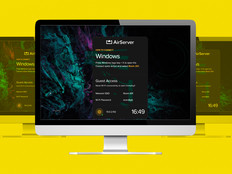Diagnostic Dynamo
Medical imagery applications can be demanding. To view medical images at full size, you need a high-resolution monitor with beaucoup screen real estate. And because of the variations in monitor brightness — even on monitors of the same brand — you need to be able to calibrate displays to a single standard.
In the medical field, that standard is Part 14 of the Digital Imaging and Communications in Medicine specifications. But because of the specialized applications, many DICOM-calibrated monitors carry hefty price tags. For a federal healthcare organization, which might need to buy several hundred, that makes digital-imaging workstations an expensive proposition.
To really take advantage of the power of digital imaging as part of medical workflow, you need those features in a monitor that is inexpensive enough to put in front of every user who needs it.
That’s what makes Eizo Nanao Technologies’ FlexScan MX300W so attractive: It delivers a dense, crisp image on its 30-inch widescreen format with DICOM calibration, and it does it for a fraction of the cost of many comparable displays.
Advantages
Out of the box, the MX300W impresses. It’s the size of a 30-inch high-definition TV, but its factory-installed mount significantly reduces its desktop footprint. The display also provides a built-in two-port USB hub so it can be set on a desktop with a keyboard and pointer device.
The MX300W combines two Digital Video Interface-driven 2-megapixel color LCDs into a single, integrated display with a widescreen 16:10 aspect ratio.
It lets you view digitized grayscale and color medical images alongside clinical data and other information on one screen. Unlike many dual-head displays of similar resolution, there’s no bezel between the two LCDs in the MX300W. It looks and acts like a single display from the user’s perspective. That means you can look at life-size images.
Why It Works for IT
One of the strongest features of the MX300W is price.
The MX300W is a fraction of the cost of many dual-headed medical displays on the market, without any of the limitations of those displays. For roughly the same cost as a similar dual-headed station, you can deploy three or more of these integrated displays.
Another strong point: the monitor’s self-calibration technology. The bundled RadiCS LE quality-control software gets data from a built-in backlight sensor through the USB connection to the monitor. The software can perform basic calibration of the monitor on its own. When a change in the luminosity of the monitor is detected, the software displays a warning icon on the Windows taskbar.
4 megapixels The number of pixels the MX300W displays on its nearly 400-square-inch screen
A variety of pre-set calibrations are available from the monitor’s own menu, accessible from buttons on the front of the display, so users can switch calibrations for applications such as endoscopic images and CT scans. There’s also an auto-detect mode for calibration, called Auto CAL Switch, which can be selected from the menu.
The combination of these features means you spend less time troubleshooting displays. The monitors also support more precise calibration through the use of an external sensor. A variety of add-on sensors are available for this task, including a clip-on that can be left in place for quality control and swung out of the way when not in use.
The MX300W also has life-extending and energy-saving features. The backlight of the monitor can be configured to switch off when the screen saver is on or when a viewer app is idle.
Disadvantages
Although its size is a major plus for many apps, the MX300W is strictly a desktop monitor. There are no wall-mount options, though there are for its smaller Eizo siblings.
Also, because the monitor can pivot between landscape and portrait mode, it necessarily sits high off the desktop in landscape mode. I found myself sometimes craning my neck a bit when looking toward the top of the screen, and wishing the monitor’s support pillar could telescope down for landscape use.
Ultimately, the net result of using the MX300W is a big plus for users. There’s less eye strain, a more consistent experience with imagery, and greater productivity and accuracy when working with clinical data and images at the same time.







